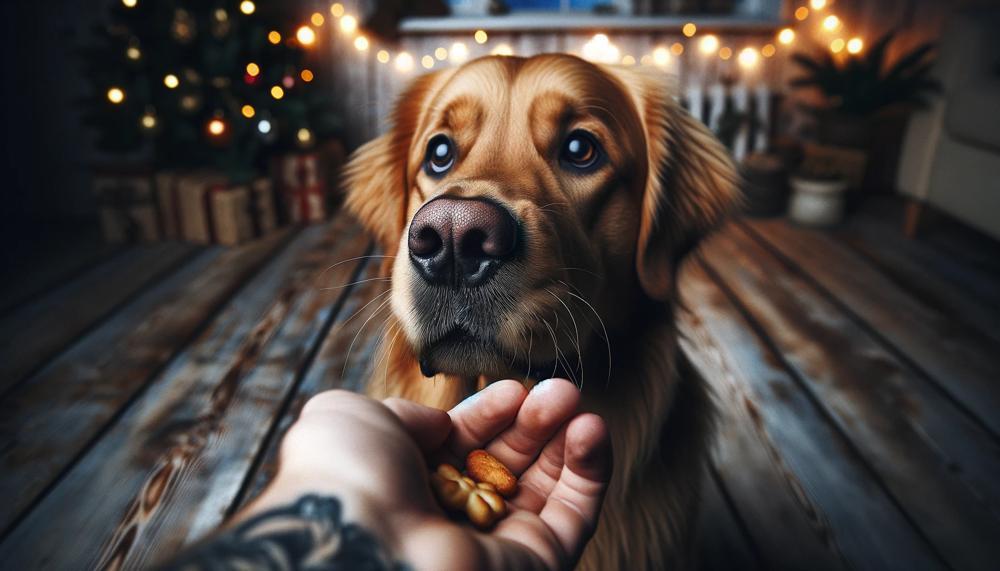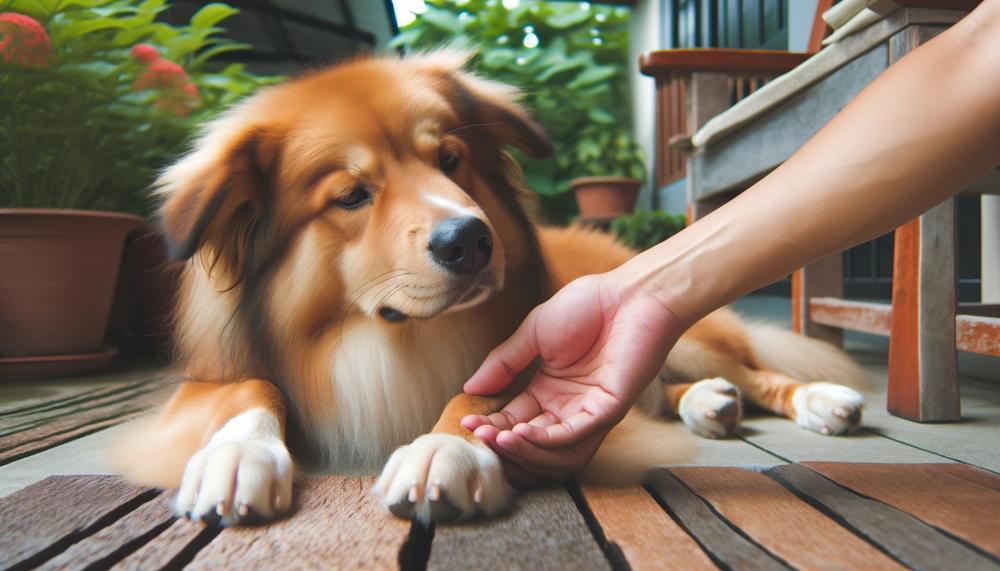As devoted dog owners, we all yearn to lavish our beloved furry companions with love and affection. But what happens when our attempts at petting are met with a growl or a swift retreat? It can be disheartening and confusing, leaving us wondering why our dogs won’t let us show them some love.
There are various reasons why your dog may not be keen on being petted, and understanding these reasons can improve your bond with your canine companion. Some common factors that may contribute to this behavior include:

- Fear or anxiety: Dogs who have had negative experiences in the past or who are generally anxious may perceive petting as a threat and react defensively.
- Lack of socialization: If a dog has not been exposed to proper socialization during their critical developmental period, they may not understand how to interact with humans.
- Pain or discomfort: Just like humans, dogs can experience physical discomfort that makes them sensitive to touch. It’s crucial to rule out any underlying medical issues before assuming behavioral problems.
- Personal boundaries: Just like people, some dogs have their own personal boundaries and may not enjoy being touched or petted by others.
Understanding these potential reasons for your dog’s behavior can help you approach them with empathy and find ways to build trust and comfort.
Do All Dogs Naturally Enjoy Being Pet?
Table of Contents
While most dogs do find pleasure in being petted, there are some who don’t naturally exhibit this behavior. Various factors such as previous experiences, unique personality traits, and breed characteristics can all contribute to a dog’s response to being petted. As a responsible dog owner, it is crucial to recognize and respect your furry companion’s preferences and not impose anything that makes them uncomfortable. Instead, focus on fostering trust and communication with your dog to establish a strong and positive bond.
Some dogs may have had negative experiences in the past that have made them wary of being petted. For example, a dog that has been abused or neglected may associate touch with pain or fear, leading them to shy away from physical contact. In contrast, dogs who have had positive experiences with their owners may become more receptive to petting and enjoy the attention.
Additionally, each dog has its own unique personality, just like humans. Some dogs may be more extroverted and enjoy physical touch, while others may be more reserved and prefer not to be touched. It’s essential to pay attention to your dog’s body language and cues to understand their preferences. Forcing a dog to be petted when they don’t want to can negatively affect their trust and relationship with their owner.
Breed characteristics can also play a role in how a dog responds to being petted. Some breeds are known for being more independent and less affectionate, which can make them less likely to enjoy being petted. On the other hand, some breeds are known for their loving and cuddly nature, making them more likely to seek out physical touch.
8 Common Reasons Why Dogs Won’t Let You Pet Them
| Cause | Description |
| Physical discomfort | Dogs may not want to be petted if they are in pain or have an injury. |
| Intimidation | If a dog feels intimidated, they may refuse to be pet by strangers or in unfamiliar environments. |
| Petting too hard | Some dogs may dislike being touched too firmly or in certain areas. |
| Anxiety | Dogs with anxiety may have difficulty with being touched, especially in stressful situations. |
| Negative past experiences | Dogs who have had unpleasant interactions with petting in the past may associate it with fear or pain. |
| Soreness or medical issues | Dogs may pull away from touch if they are experiencing soreness or medical problems. |
| Lack of trust or fear of humans | Some dogs may struggle to trust humans and may be hesitant to be pet by them. |
| Personal boundaries | Just like humans, some dogs have preferences for personal space and may not enjoy being touched constantly. |
In essence, there are multiple factors that can contribute to a dog’s reluctance to be petted, such as physical discomfort, past experiences, anxiety, and personal preferences. As responsible owners, it is crucial to understand our dog’s behavior and create a safe and comfortable environment for them.
My Dog Suddenly Does Not Want To Be Pet, Why?
There could be multiple factors contributing to this sudden shift in your dog’s behavior. Here are a few potential explanations to consider:
- Discomfort or pain: Similar to humans, dogs can experience discomfort or pain due to various reasons such as injuries, illnesses, or age-related issues. If your furry friend has recently started avoiding being pet, it could be due to physical discomfort.
- Negative past experiences: Dogs have excellent memories and can associate certain actions with past negative experiences. If your dog has had a bad encounter while being petted, they may avoid it in the future to protect themselves.
- Anxiety or fear: Dogs can also experience anxiety and fear for various reasons, such as changes in their environment, new people or pets in the household, or past traumatic events. If your dog shows signs of anxiety or fear while being petted, they may start avoiding it altogether.
- Personal boundaries: Just like humans, dogs have personal boundaries and may not always be in the mood for physical affection. If your dog has suddenly started avoiding being petted, it could simply be because they are not in the mood for it at that particular moment.
To determine the exact cause behind your dog’s change in behavior, it is crucial to pay attention to their body language and consult a veterinarian if necessary. It is also vital to respect your dog’s boundaries and give them space when they are not comfortable with being petted.
What If My Dog Just Doesn’t Like To Be Touched?
If your furry friend doesn’t enjoy being touched or petted, it’s important to address the underlying issue causing their discomfort or aversion. Here are some steps you can take to help your dog:
- Observe their body language: Take note of how your dog reacts when touched. If they show signs of discomfort, such as pulling away, growling, or baring their teeth, it’s a clear indication that they don’t enjoy the physical contact in that moment.
- Respect their boundaries: Just like humans, dogs have personal boundaries and preferences. It’s important to respect these boundaries and not force physical contact on them if they are not comfortable with it.
- Identify the cause: It’s crucial to identify the root cause of your dog’s aversion to being touched. It could be due to an underlying medical issue, past trauma or negative experiences, fear or anxiety, or a simple dislike for certain types of touch.
- Seek professional assistance: If your dog’s behavior is sudden and unexplainable, it’s best to seek help from a professional trainer or behaviorist. They can help you understand why your dog is avoiding touch and provide guidance on how to address the issue.
- Desensitization and counter-conditioning: With the help of a professional, you can use positive reinforcement techniques like desensitization and counter-conditioning to change your dog’s response to touch. This involves gradually exposing them to touch in a controlled and positive environment while rewarding them for remaining calm and relaxed.
- Be patient and understanding: Changing a behavior takes time and patience. It’s important to be patient with your dog and understand that their aversion to touch is not personal. By respecting their boundaries and using positive reinforcement techniques, you can help them overcome their discomfort and build a trusting relationship with them.
Why Does My Puppy Bite Me When I Try To Pet Them?
There are various reasons why your puppy may bite when being petted. These can include their natural instincts, lack of proper socialization, and a desire for attention. However, this behavior can be effectively corrected through proper training and socialization techniques, as well as setting clear boundaries and utilizing positive reinforcement.
One of the main reasons puppies may bite when being petted is due to their natural instincts. As pack animals, puppies are used to nipping and biting as a form of play with their littermates. However, this behavior can become problematic if it continues into adulthood. This is where proper training and socialization come into play.
Lack of socialization can also contribute to a puppy’s tendency to bite when being petted. Without exposure to different people and situations, puppies may not know how to properly interact with humans and may resort to biting as a form of communication. This is why it’s important to socialize your puppy from a young age, exposing them to various people, animals, and environments.
Another reason for biting during petting could be a desire for attention. Puppies are naturally curious and crave attention from their owners. If they feel like they are not getting enough attention, they may resort to biting as a way to get it. It’s important to set boundaries and teach your puppy that biting is not an acceptable way to seek attention.
To correct this behavior, it’s important to train your puppy consistently and positively reinforce good behavior. This can include using treats or toys when your puppy behaves appropriately during petting sessions. It’s also important to set boundaries and teach your puppy that biting is not acceptable by consistently redirecting them towards appropriate chew toys.
Conclusion
In conclusion, it’s essential for dog owners to understand that not all dogs are fond of being petted.
While some may enjoy it, others may have various reasons for not wanting physical affection. These reasons could range from fear or anxiety to lack of socialization, pain or discomfort, and personal boundaries.
It’s crucial to respect our furry companions’ preferences and understand their unique needs in order to build a strong bond with them. Each dog is an individual with their own preferences and boundaries when it comes to physical touch, and as responsible owners, it’s our duty to recognize and honor these differences.
By using positive reinforcement techniques, we can help our dogs overcome any aversions they may have towards being petted and create a safe and comfortable environment for them.






